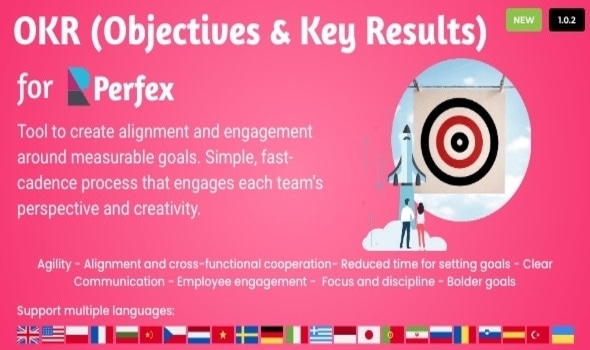OKRs v1.0.2 – Objectives and Key Results for Perfex CRM
Brief description
OKR (Objectives and Key Results) is a goal system. It is a simple tool to create alignment and engagement around measurable goals. The big difference from traditional planning methods? OKRs are frequently set, tracked, and re-evaluated – usually quarterly. OKR is a simple, fast-cadence process that engages each team’s perspective and creativity.Creating alignment in the organization is one of the main OKR benefits. The goal is to ensure everyone is going in the same direction, with clear priorities, in a constant rhythm. OKR’s original concept came from Intel and spread to other Silicon Valley companies. Google adopted OKR in 1999, during its first year. It supported Google’s growth from 40 employees to more than 60,000 today.Besides Google, other companies use OKR, including Spotify, Twitter, LinkedIn, and Airbnb. But the OKR system is not only for digital companies. Walmart, Target, The Guardian, Dun and Bradstreet, and ING Bank are also using OKR.
So, as the name implies, OKR has two components, the Objective and the Key Results:
- Objectives are memorable qualitative descriptions of what you want to achieve. Objectives should be short, inspirational and engaging. An Objective should motivate and challenge the team
- Key Results are a set of metrics that measure your progress towards the Objective. For each Objective, you should have a set of 2 to 5 Key Results. More than that and no one will remember them.
The main OKR benefits are:
- Agility: Shorter goal cycles enable faster adjustments and better adaptation to change, increasing innovation and reducing risks and waste.
- Alignment and cross-functional cooperation: The use of shared OKRs improves collaboration among different teams, solving interdependencies and unifying competing initiatives.
- Reduced time for setting goals: OKR simplicity makes the goal setting process faster and easier, drastically reducing the time and resources spent on setting goals.
- Clear communication: Transparency and simplicity enable the team to understand the goals and priorities of the organization as well as how each individual can contribute.
- Employee engagement: OKR bi-directional approach for goal setting connects the employees with the company’s objectives, increasing engagement.
- Autonomy and accountability: Teams receive a clear direction and are free to choose how to achieve their OKRs. They become responsible for their objectives, with clear success criteria known to the whole company, creating mutual obligations.
- Focus and discipline: The reduced number of goals creates focus in the organization and disciplines efforts and initiatives.
- Bolder goals: Decoupling OKRs from compensation and using stretch goals, even partially, enable the team to set bolder, challenging goals.
Original script and Demo: https://codecanyon.net/item/okrs-objectives-and-key-results-for-perfex-crm/28280122
https://usendify.com/Ax3AFsFi
https://mega4up.com/op4kkl62e9t9
https://uploadrar.com/toy70whasrf1
https://uptobox.com/0z6ue45nkghq
https://1fichier.com/?k9woln45mh6pja0dwv2l


